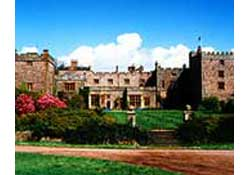This historic 13th-century castle overlooks the Irish Sea and the Lake District. The Pennington family have owned and lived in it for over 800 years.
Muncaster Castle, winner of the Best Visitor Attraction in the Cumbria for Excellence Awards 2002, offers lots to see and do. It’s thought to have been built on the site of Roman foundations and the first buildings included the defensive pele tower and Great Hall, added in the 13th century by the estate’s first owner, Alan de Penitone. Penitone’s descendants (now ‘Pennington’) still live there. In 1464, Henry VI sheltered in the Castle when Sir John Pennington’s shepherds found him wandering in the area after the Battle of Hexham. When he left, the King left behind a drinking bowl, saying that the Penningtons would survive and prosper so long as the bowl remained unbroken. The bowl is still intact today and is known as the ‘luck of Muncaster’. In 1783, Lord John Muncaster built a tower known as the Chapels to mark the place where the King was said to have been found, and over the 19th century the castle was remodelled by Anthony Salvin for the Barons Muncaster. He covered over the courtyard to make a drawing-room which has a barrel ceiling made by two Italian plasterers.
The gardens of the Castle also add to the splendour of the greenery in the area. There are many rare plants in the Himalayan gardens and one of the largest collections of owls in the world - the Castle is also the headquarters of the World Owl Trust. Giant eagle owls, fish owls and tiny pygmy owls join buzzards, kestrels and red kites in flying displays which take place during the season. You can also see wild herons feeding in the afternoon, or try to find your way out of the meadow-vole maze, where everything is built to make you feel two and a half inches tall.

Temporarily Closed !
- Monday:
-
10:30 - 17:00
- Tuesday:
-
10:30 - 17:00
- Wednesday:
-
10:30 - 17:00
- Thursday:
-
10:30 - 17:00
- Friday:
-
10:30 - 17:00
- Saturday:
-
10:30 - 17:00
- Sunday:
-
10:30 - 17:00











